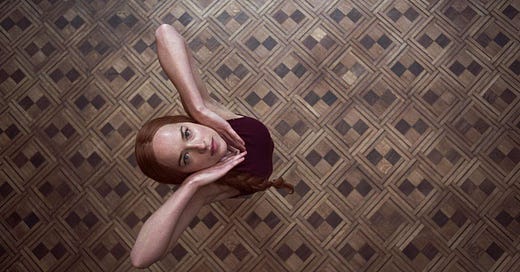I have a MASSIVE love for Dario Argento’s “Suspiria”, one of the great great great horror movies of all-time, and the start of the wild and wacky “Three Mothers” trilogy. Yes, I was the guy wildly (and maybe pointlessly?) pumping his fist in the theater during “Mother Of Tears”, the third and least-beloved of that series. But I love horror, and I’m a completist about franchises. So I’d give anybody the benefit of the doubt to remake “Suspiria”, because while it’s a classic movie, it’s also a classic mood. There’s flexibility to craft an entirely new beast, of new bones, new blood.
Director Luca Guadagnino actually takes this affair in a wildly different direction. He starts at the same place – Suzy Bannion in the 1970’s. But we’re in Germany, after she fled from an abusive Mennonite family. There is a frightening edge to the idea that the original Bannion from the seventies film had an unexplained background, but by revealing a colorful new truth about this character, Guadagnino uses an early mood-setting sequence set in Ohio to foreshadow the control that’s about to be enforced upon Suzy (this time, Dakota Johnson).
And then it just gets wilder from there. Argento made “Suspiria” at a time where people lacked the firsthand experience of certain subcultures, so he could invent whatever he wished about the ballerinas at the heart of the original film. This movie is coming out in the internet age, which means there is a rigorous sense of reality towards what is no longer pink-tutu ballet and is now aggressive, political interpretive dance. This cements itself within your mind during one particular early sequence that crosscuts between Suzy commanding the floor and another dancer seeing her limbs and bones, mid-dance, begin to flutter and flop through the skin, puppeteered to death by a particularly witchy force.
Suzy, of course, is being groomed. By unseen supernatural forces, but also by Tilda Swinton, who is both the headmistress and also, apparently, a male therapist who was the last person to see another student missing from the school. I’m not sure exactly if Swinton popping up in makeup as a male German doctor is part of the witchiness – is the fact that this part is played by a fake actor named Lutz Ebersdorf a suggestion that witches have polluted the very movie you’re watching? The dizzying final sequence seems to confess as much. Sometimes a scene has such a transformative power that it feels like you’re inside of it for your entire life. “Suspiria”’s final witches’ circle is one of those scenes.
One of the highlights of the original film was the all-timer of a score by prog outfit Goblin. The main reason I would think you should avoid a remake of this would be because you’re not going to top the music of that first film. I’ll never forgive remakes like “The Fog” not even bothering to mimic the sound of the original source material and settling for only generic orchestral scores. So I was pleasantly surprised that the music from “Suspiria New Flavor” would be courtesy of the first film composition by Thom Yorke, lead singer of my favorite band Radiohead. I suppose it’s more conventional than the work by Goblin, more tuneful, more based in horror soundscapes than the rockin’ original. But like the original, you hear Yorke’s work within the movie and you know this isn’t just ordinary horror filler. I have listened to this countless times since I have seen the movie.
I wished I had access to that music when I was down. Music is a very specific component of life in prison. In my earlier locations, I was close enough to society to be able to get pretty solid radio stations, a few college broadcasts, a few actually-solid Top 40 outlets. But for many, you have the option to buy your own MP3 player, which seemed dated from the nineties. I eventually bought my own, once I ended up in an institution far away from any pleasurable frequency.
There was a database for music, and it had pretty arbitrary selections. An example would be Radiohead, where the system had no recent Radiohead selections beyond 2003’s “Hail To The Thief”, and none prior to 1997’s “OK Computer”. Albums would appear and vanish within months, and many were mislabeled. Most songs cost a little over $1.50, and some were in the neighborhood of $1.20, which were the product of “credits” that were purchased – the old habit of overcharging you based on uneven price and transfer amounts.
There would be new music every few weeks, usually on a Tuesday, I think the third week of the month. And you could spend hours scouring the new stuff, albums and albums of stuff. Sometimes you’d get a brand new release by a popular artist, and sometimes you’d get dozens of anonymous albums, sometimes catalog sounds and effects, and even older soundtracks with dozens of tracks of nearly dead air.
The way the money worked was that you had to update your MP3 player every fifteen days. That meant buying music at least every fifteen days, or losing access to all your tracks. Doing a manual update without buying anything new would take hours, and the charging stations numbered only five or six in dorms that housed over a 100 people. As far as ways to bleed your money out, a couple dollars at a time, it wasn’t a bad system.







